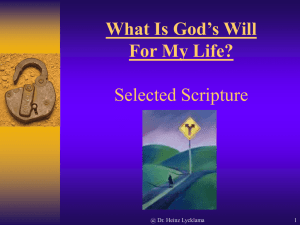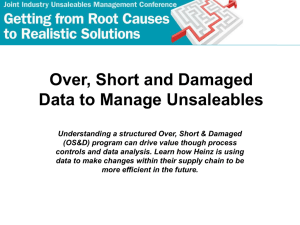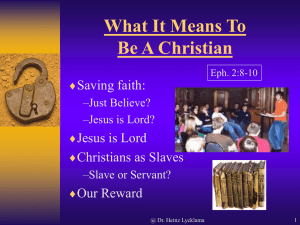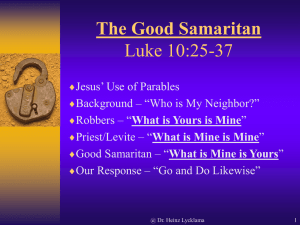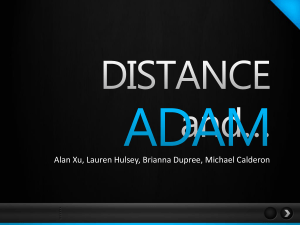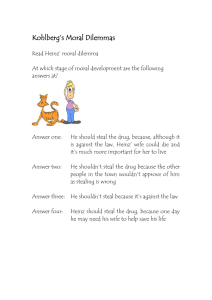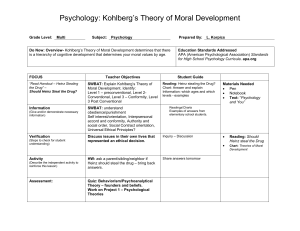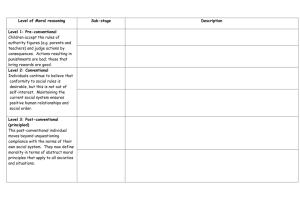scicreat - Heinz Lycklama's Website
advertisement
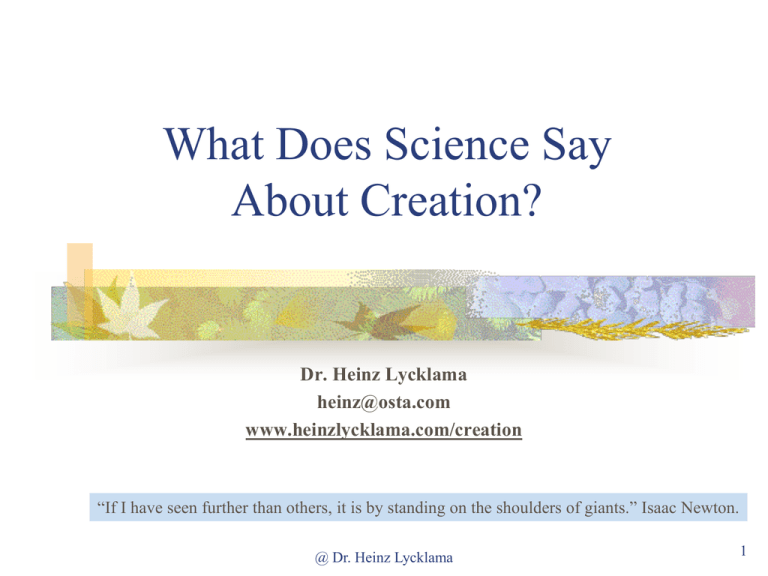
What Does Science Say About Creation? Dr. Heinz Lycklama heinz@osta.com www.heinzlycklama.com/creation “If I have seen further than others, it is by standing on the shoulders of giants.” Isaac Newton. @ Dr. Heinz Lycklama 1 Science and Creation What is science? Scientific method Origins – Evolution or Creation? Creation and Evolution models Which model best fits the facts? Basic predictions of the models Looking at the scientific evidence Origin of matter, energy and natural law 1st and 2nd Laws of Thermodynamics @ Dr. Heinz Lycklama 2 What Does Science Have To Say? Harrison Matthews, in the “Foreword” to the 1971 edition of “Origin of Species by Natural Selection”, by Charles Darwin states that “Belief in evolution is thus exactly parallel to belief in special creation - both are concepts which believers know to be true but neither, up to the present, has been capable of proof.” An Objective statement of fact! @ Dr. Heinz Lycklama 3 Is This Science? “Since Darwin, every knowing person agrees that man is descended from the apes. ... Today, of course, there is no such thing as the theory of evolution; it is the fact of evolution. The only arguments now are over technical problems, but the basic fact of evolution is so clearly established that no scientist worries about it any more.” - so states Ernst Mayr, professor of Biology at Harvard. A Subjective statement! @ Dr. Heinz Lycklama 4 Science “Operational” Science Postulate theory -> make observations -> prove/falsify theory Using the Scientific Method “Origins” Science Were you there at the beginning? Model of Creation Model of Evolution Which model fits the observed facts best? “Forensic” science @ Dr. Heinz Lycklama 5 Scientific Methodology Make observations Develop a hypothesis or theory that explains the observations Conduct experiments to test accuracy and predictions made by the theory Draw conclusions Repeat experiments to verify results and eliminate sources of inaccuracy Report results so others can repeat the experiment(s) @ Dr. Heinz Lycklama 6 Theory Criteria To apply scientific methodology, the theory must meet these criteria: Must be falsifiable or verifiable Must make quantifiable predictions Experimental results must be repeatable Must be as simplistic as possible with no unnecessary components (Occam’s Razor) Adherence to the methodology allows for selfcorrection and increases confidence in the assumptions made by scientific philosophy @ Dr. Heinz Lycklama 7 Origins - Evolution or Creation? “Science is the search for truth” Hypothesis, theory, model, law, or fact? Fact – proven to be true Law – no known exception Theory – testable, falsifiable, based on empirical findings Hypothesis – provisionally explains some fact Model – simplified representation of reality Which is Evolution? Creation? A model – let’s see why … @ Dr. Heinz Lycklama 8 Models of Origins We can neither observe nor repeat “origins” Origins “theories” cannot be tested or proven We have two models (not theories) of origins Models can be compared as to their respective capacities for correlating observable data Evolutionists regard Evolution as “a proven fact.” Creation and Evolution They believe that Evolutionism is science and that Creationism is religion Evolutionists are unable to prove evolution Thousands of scientists believe in Creation @ Dr. Heinz Lycklama 9 Creation Model Involves a process of special creation in the beginning All the basic laws and categories of nature brought into existence by special creative processes which are no longer in operation today Distinct kinds exist today as they have existed in the past Processes of Creation replaced by processes of conservation @ Dr. Heinz Lycklama 10 Evolution Model Explains origin, development and meaning of all things in terms of natural laws and processes which operate today as they have in the past No extraneous processes requiring an external agent (i.e. a Creator) are permitted The universe in all respects evolves itself into higher levels of order (particles to people), elements -> complex chemicals -> simple living systems -> complex life -> man @ Dr. Heinz Lycklama 11 More on Origins Models Creation cannot be proved: Not happening now, so far as can be observed The scientific method cannot repeat Creation Cannot ascertain whether Creation took place (except through divine revelation) Evolution cannot be proved: Operates too slowly to be measurable, if it is taking place The scientific method cannot be used to measure it Small variations in organisms, observed today, are not relevant (can’t be used to distinguish between Creation and Evolution) @ Dr. Heinz Lycklama 12 Which Model Best Fits The Facts? Creation and Evolution are the only two models of origins Both models should be considered as equal alternatives and evaluated objectively in terms of their relative abilities to correlate and explain scientific data The model that incorporates the most data and has the smallest number of unresolved issues is the most likely to be true @ Dr. Heinz Lycklama 13 Basic Predictions of The Models Category Basic Predictions of Evolution Model Basic Predictions of Creation Model Galactic universe Galaxies changing Structure of stars Stars changing into other types Stars unchanged Other heavenly bodies Building up Breaking down Types of rock formations Different in different “ages” Similar in all “ages" Appearance of life Life evolving from non-life Life only from life Array of organisms Continuum of organisms Distinct kinds of organisms Appearance of kinds of life New kinds appearing @ Dr. Heinz Lycklama Galaxies constant No new kinds appearing 14 More Predictions of The Models Category Basic Predictions of Evolution Model Basic Predictions of Creation Model Mutations in organisms Beneficial Harmful Natural selection Creative process Conservative process Fossil record Innumerable transitions Systematic gaps Appearance of man Ape-human intermediates No ape-human intermediates Nature of man Quantitatively superior to animals Qualitatively distinct from animals Origin of civilization Slow and gradual Contemporaneous with man @ Dr. Heinz Lycklama 15 Looking At The Scientific Evidence Origin of matter, energy and natural law Origin of the solar system Teleology – study of evidences of design in nature, e.g. Anthropic Principle Classification of biological organisms Natural selection and mutations (vestigial organs) @ Dr. Heinz Lycklama 16 More on the Scientific Evidence Origin of man Origin of life – probability The fossil record Geologic ages – Uniformitarianism vs. Catastrophism Age of the world (earth/universe) @ Dr. Heinz Lycklama 17 #1 - Origin of Matter, Energy & Natural Law Evolution model predicts: Matter, energy and laws may still be changing May have changed in the past since there is no external agent to bring Evolution to a stop Systems can evolve to higher levels of complexity Creation model predicts: Basic laws would not now be changing Fundamental nature of matter and energy would not now be changing Finished in the past, conserved in the present Matter should go from order to disorder @ Dr. Heinz Lycklama 18 First Cause – Divine or Matter? The First Cause of Limitless Space – must be infinite The First Cause of Endless Time – must be eternal The First Cause of Boundless Energy – must be omnipotent The First Cause of Universal Interrelationships – must be omnipresent The First Cause of Infinite Complexity – must be omniscient The First Cause of Moral Values – must be moral The First Cause of Spiritual Values – must be spiritual The First Cause of Human Responsibility – must be volitional The First Cause of Human Integrity – must be truthful The First Cause of Human Love – must be loving The First Cause of Life – must be living @ Dr. Heinz Lycklama 19 Conceptual Systems of Science Cause and Effect - an omnipotent Creator is an adequate cause for all observable effects in the universe Energy Conservation – energy can be converted from one form into another, but can neither be created nor destroyed Classification and Order - table of chemical elements, biological taxonomy, hierarchy of star types. All entities are in a state of flux in the evolution model Processes - all processes are well-defined and orderly. If not, there is no point to scientific study. Creation predicts “purpose” and “meaning” These systems all favor the creation model! @ Dr. Heinz Lycklama 20 Conceptual Systems of Science - 2 Forces and Fields - types of forces in nature (electromagnetic, gravitational, nuclear and weak) have always acted the same from the beginning These forces did not evolve Environmental Interdependence – the environment coupled with natural selection constitutes a powerful mechanism to conserve the created kinds and balance of nature Energy Decay – changes always tend to go in a “downward” direction such that there results a net decrease in the “availability” of the converted energy for further useful work These systems all favor the creation model! @ Dr. Heinz Lycklama 21 The Laws of Nature Everything in the universe is bound by laws Physics, chemistry, mathematics, life, logic Universal constants, planetary motion Laws of nature are uniform throughout the universe Explain the logical orderly state of the universe Consequences of laws of nature Laws require a law-giver Laws of nature are consistent with creation Laws of nature make science possible! “ordinances of heaven and earth” Jer. 33:25 @ Dr. Heinz Lycklama 22 The Laws of Physics Describe behavior of universe at its most fundamental level How the universe operates today How light propagates How energy is transported How gravity operates How mass moves through space Mathematical in nature F = ma E = mc**2 [acceleration of mass] [conservation of energy] @ Dr. Heinz Lycklama 23 The Laws of Physics - 2 Universal constants Strength of fundamental forces, e.g. gravity Mass of fundamental particles, e.g. electron Electromagnetic coupling constant makes molecules possible Anthropic Principle Laws of physics fine-tuned for human life Derived laws of physics and chemistry @ Dr. Heinz Lycklama 24 Laws of Chemistry Life requires a specific chemistry Laws of chemistry just right for life Depend on laws of physics Hydrogen and Oxygen react to form water Human body depends on chemical reactions Information stored on long molecule – DNA Special properties, e.g. ice floats Elements organized into periodic table Properties of elements and compounds Outermost electrons determine physical characteristics of the atom @ Dr. Heinz Lycklama 25 @ Dr. Heinz Lycklama 26 Laws of Planetary Motion Kepler discovered that planets in our solar system obey three laws of nature Planets orbit in ellipses Planets sweep out equal areas in equal times Exact mathematical relationship between planet’s distance from the sun and its orbital period, i.e. p**2 = a**3 Kepler’s laws also apply to orbit of moons Laws of planetary motion are derived from laws of gravity and motion (Newton) @ Dr. Heinz Lycklama 27 Laws of Mathematics Laws of physics are highly mathematical in nature Laws and principles of mathematics Would not work otherwise Addition, multiplication, transitive, etc. Commutative properties of addition/multiplication Binomial theorem Laws of mathematics Abstract, not attached to any specific part of the universe A “transcendent truth”, not part of the physical universe “Mathematics is the language in which the gods talk to people.” Plato @ Dr. Heinz Lycklama 28 Nature of Mathematical Laws Secular view of law of mathematics Cannot account for the laws Not part of the physical universe Christian view of law of mathematics God’s nature is logical and mathematical Any created universe is mathematical in nature There is a God beyond the universe Mathematics reflects the thoughts of God Mathematics illustrates God’s immutability Discovered by human beings, not invented “Thinking God’s thoughts after Him.” Kepler @ Dr. Heinz Lycklama 29 Laws of Logic Transcendent truths Depended on by the laws of nature Law of non-contradiction Make reasoning possible Cannot have both “A” and “not A” at the same time and in the same relationship God cannot contradict Himself, Num. 23:19 God is logical Reflect God’s nature Man, created in God’s image, instinctively knows the laws of logic Secularist cannot account for these laws @ Dr. Heinz Lycklama 30 More On The Natural Laws The first two laws of thermodynamics are constant: 1. 2. Other constant laws include: The total energy of any system remains the same The entropy of a system increases over time Law of gravity Conservation of momentum Conservation of electric charge Did natural laws evolve? There is no evidence of this Laws of nature are uniform throughout the cosmos @ Dr. Heinz Lycklama 31 Asimov’s Definition of 1st Law “To express all this, we can say: ‘Energy can be transferred from one place to another,or transformed from one form to another, but it can be neither created nor destroyed’.” “Or we can put it another way: ‘The total quantity of energy in the universe is constant.’ When the total quantity of something does not change, we say that it is conserved.” “The two statements given above, then, are two ways of expressing ‘the law of conservation of energy.’ This law is considered the most powerful and most fundamental generalization about the universe that scientists have ever been able to make.” @ Dr. Heinz Lycklama 32 The 2nd Law of Thermodynamics 2nd Law - The entropy of a system increases with time Entropy is defined as “a measure of the quantity of energy not capable of conversion into work” 2nd Law holds in the fields of classical thermodynamics (unavailability of energy for further work), statistical thermodynamics (decreased order of the system’s structure), as well as in informational thermodynamics (lost/distorted information) Creation predicts and is supported by the First and Second Laws of Thermodynamics Let’s see what Dr. Gish [ICR] has to say … @ Dr. Heinz Lycklama 33 Comments on nd 2 Law “… all real processes go toward a condition of greater probability. The probability function generally used in thermodynamics is entropy. … the smaller the number of possible arrangements the less the entropy. If there is only one place for each thing… the entropy is zero; if the system is highly random… the entropy is a large number. Thus orderliness is associated with low entropy; randomness with high entropy. In the systems we ordinarily study there are a large number of possible arrangements so the entropy is a large number. The second law of thermodynamics says that left to itself any isolated system will go toward greater entropy, which also means toward greater randomness and greater likelihood.” Blum, Harold 1955. Perspectives in Evolution, American Scientist 43. @ Dr. Heinz Lycklama 34 Asimov’s Definition of 2nd Law “Another way of stating the Second Law, then, is: ‘The universe is constantly getting more disorderly’.” Asimov, Isaac. 1970. In the game of energy and thermodynamics you can’t even break even. Smithsonian 1 (August): 10. @ Dr. Heinz Lycklama 35 Asimov’s Definition of 2nd Law “Viewed that way, we can see the Second Law all about us. We have to work hard to straighten a room, but left to itself, it becomes a mess again very quickly and very easily. Even if we never enter it, it becomes dusty and musty.” @ Dr. Heinz Lycklama 36 Asimov’s Definition of 2nd Law “How difficult to maintain houses, and machinery, and our own bodies in perfect working order; how easy to let them deteriorate.” @ Dr. Heinz Lycklama 37 Asimov’s Definition of 2nd Law “In fact, all we have to do is nothing, and everything deteriorates, collapses, breaks down, wears out, all by itself – and that is what the Second Law is all about.” @ Dr. Heinz Lycklama 38 More on the 2nd Law All things left to themselves always tend to go from the complex to the simple, from the organized to the disorganized. Evolution would require just the opposite… the continual building up from the simplest to the more complex forms. @ Dr. Heinz Lycklama 39 @ Dr. Heinz Lycklama 40 The Biologist’s Problem “…the apparent contradiction by evolution of the second law of thermodynamics. Systems should decay through time, giving less, not more, order.” Lewin, Roger. 1982. A downward slope to great diversity. Science 217 (24 September):1239. @ Dr. Heinz Lycklama 41 The Evolutionist’s Response “One legitimate response to this challenge is that life on earth is an open system with respect to energy and therefore the process of Evolution sidesteps the law’s demand for increasing disorder with time.” @ Dr. Heinz Lycklama 42 More on the 2nd Law Entropy (simplicity) increases in a closed system. @ Dr. Heinz Lycklama 43 2nd Law and Open Systems Entropy normally increases more rapidly in a system open to the influx of external energy @ Dr. Heinz Lycklama 44 Increasing Complexity Conditions for increasing complexity in an Open System: 1. 2. Open system Available energy Note: These two conditions are satisfied by all systems on earth Therefore, though necessary, they are not sufficient conditions @ Dr. Heinz Lycklama 45 Storage Required 3. Mechanism for storing and a. b. c. converting incoming energy Photosynthesis in plants Metabolism in animals Machinery in artificial construction @ Dr. Heinz Lycklama 46 Program Required 4. Program to “direct” the growth of complexity Examples: a. b. “Genetic code” in DNA of living systems “Plans and specifications” for construction of an artificial system @ Dr. Heinz Lycklama 47 Insufficiency of External Energy “…the simple expenditure of energy is not sufficient to develop and maintain order. A bull in a china shop performs work, but he neither creates nor maintains organization. The work needed is particular work; it must follow specifications; it requires information on how to proceed.” Simpson, George. G., and William Beck. 1965. Life: An introduction to biology. 2d ed. New York: Harcourt, Brace, and World Pub. Co. p. 466. @ Dr. Heinz Lycklama 48 Conditions For Increasing Complexity in an Open System Necessary, but not sufficient conditions: 1. Open System 2. Available Energy Additional requirements: 3. Mechanism for storing and converting incoming energy 4. Program (to “direct” the growth of complexity) @ Dr. Heinz Lycklama 49 Keeping Score Creation Evolution Laws of nature & Thermodynamics TOTAL = 1 @ Dr. Heinz Lycklama 0 50
